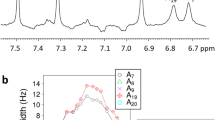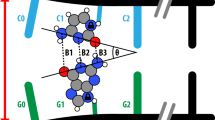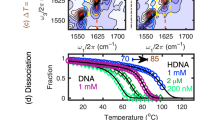Abstract
Nuclear magnetic resonance is a technique which permits direct observation of the Watson–Crick hydrogen-bonded ring imino protons (guanine N1H and thymine N3H). As the formation and disruption of hydrogen bonds of double-helical RNA and DNA structures are key events during various biological processes, NMR thus provides a useful tool for studying the fluctuational mobility of the individual base pairs. Indeed, several NMR studies of oligo- and polynucleotides have been carried out to probe the structure and dynamics of nucleic acids in solution (for a review see ref. 1). The present study constitutes the first part of our attempt to assess the influence of non-complementary base pairs on the stability of nucleic acid double helices. We report the spectral assignment and temperature-dependent NMR profiles of the hydrogen-bonded imino protons of the two DNA fragments shown in Fig. 1. The assignment is based solely on experimental grounds using the principle of chemical modification. It will be demonstrated that the introduction of a non-complementary (wobble) base pair in a DNA duplex introduces an extra melting site in addition to the sequential melting which starts with the terminal base pairs in the double helix structure.
This is a preview of subscription content, access via your institution
Access options
Subscribe to this journal
Receive 51 print issues and online access
$199.00 per year
only $3.90 per issue
Buy this article
- Purchase on Springer Link
- Instant access to full article PDF
Prices may be subject to local taxes which are calculated during checkout
Similar content being viewed by others
References
Hilbers, C. W. in Magnetic Resonance Studies in Biology (ed. Shulman, R. G.) (in the press).
Boom, J. H. van, Burgers, P. M. J. & Deursen, P. H. van Tetrahedron Lett., 869–872 (1976).
Rooij, J. F. M. de, Wille-Hazeleger, G., Deursen, P. H. van, Serdÿn, J. & Boom, J. H. van Recl. Trav. Chim. Pays-Bas (in the press).
Patel, D. J. Biochemistry 13, 2396–2402 (1974).
Patel, D. J. & Tonelli, A. E. Biopolymers 13, 1943–1964 (1974).
Altona, C., Boom, J. H. & Haasnoot, C. A. G. Eur. J. Biochem. 71, 557–562 (1976).
Patel, D. J. Biopolymers 16, 1635–1656 (1977).
Selsing, E., Wells, R. D., Early, T. A. & Kearns, D. R. Nature 275, 249–250 (1978).
Giessner-Prettre, C. & Pullman, B. J. theor. Biol. 27, 87–95 (1970).
Arnott, S. & Hukins, D. W. L. Biochem. biophys. Res. Commun. 47, 1504–1509 (1972).
Lehninger, A. L. in Biochemistry 2nd edn, 876 (Worth, 1975).
Grosjean, H. J., Henau, S. de, & Crothers, D. M. Proc. natn. Acad. Sci. U.S.A. 75, 610–614 (1978).
Gillam, S., Waterman, K. & Smith, M. Nucleic Acids Res. 2, 625–634 (1975).
Dadok, J. & Sprecher, R. F. J. Magnetic Resonance 13, 243–248 (1974).
Haasnoot, C. A. G. & Altona, C. Nucleic Acids Res. 6, 1135–1149 (1979).
Author information
Authors and Affiliations
Rights and permissions
About this article
Cite this article
Cornelis, A., Haasnoot, J., den Hartog, J. et al. Local destabilisation of a DNA double helix by a T–T wobble pair. Nature 281, 235–236 (1979). https://doi.org/10.1038/281235a0
Received:
Accepted:
Published:
Issue Date:
DOI: https://doi.org/10.1038/281235a0
This article is cited by
-
Amplification of chirality based upon the association of nucleic acid strands of opposite handedness
Journal of Molecular Evolution (1987)
-
Loopstructures in synthetic oligonucleotides. Hairpin stability and structure studied as a function of loop elongation
Journal of Biosciences (1985)
-
Imperfect complementarity and RNA structure
Journal of Biosciences (1985)
-
Secondary structures of influenza and Sendai virus RNAs
Archives of Virology (1980)
Comments
By submitting a comment you agree to abide by our Terms and Community Guidelines. If you find something abusive or that does not comply with our terms or guidelines please flag it as inappropriate.



